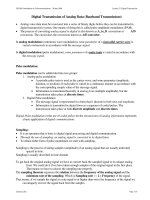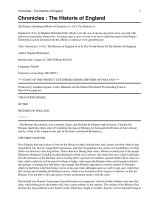Econometrics – lecture 6 – extended forms of estimations
Bạn đang xem bản rút gọn của tài liệu. Xem và tải ngay bản đầy đủ của tài liệu tại đây (252.57 KB, 11 trang )
EXTENDED FORMS OF
REGRESSION MODELS
Dr. TU Thuy Anh
Faculty of International Economics
1
COBB-DOUGLAS FUNCTIONS
• Production function:Y = aKαLβ
=> lnY = a1+αln(K)+ βln(L)
=> lnY = a1+αln(K)+ βln(L) + u
• Example:
• Interpretation:
– α: when K increases by 1%, L unchanged then Y increases by
α%; the elasticity
– β: when L increases by 1%, K unchanged then Y increases by
α%
– a1: when K=L =1=> Y=exp(a1)
2
POLINOMIAL FUNCTION
Cost function:
TC = a1+a2Q?
TC = a1+a2Q+a3 Q2?
TC = a1+a2Q+a3 Q2 +a4Q3?
TC = a1+a2Q+a3 Q2 +a4Q3+u
3
MODELS WITH DUMMY VARIABLES
Returns and risk: returns = a1 + a2risk + u
However:
2 different intercepts
4
MODELS WITH DUMMY VARIABLES
How to solve the problem:
run a regression for each group, or
use one regression, but add “the state of the market” as another
independent variable *
For the (*), need to “numerate” the “state of the market”: use
dummy variables
=>returns = a1 + a2risk + a3D+ u (3)
5
DUMMY
Obs.
returns
risk
Bull/bear
D
1
11.5
3.0
Bull
1
2
11.7
3.5
Bear
0
3
12.0
4.0
Bear
0
..
6
..
30
11.8
2.6
Bull
1
31
12.0
3.5
Bear
0
THE INTERPRETATION OF a3
• Write (3) as:
returnsBull = a1 + a2risk + a3+ u (4)
returnsBear= a1 + a2risk +
u (5)
• a3: if risk = 0 then returns in the bull market are greater than
in the bear market by a3 unit
• Example:
– returns^ = 2 + 0.3risk + 0.1D?
• Note: we implicitly presume that a2 is the same in the two
markets
7
MODELS WITH DUMMY VARIABLES
Q: Does the market respond the same to risk in two different
states?
If not:
both slope and intercept are
different
8
MODELS WITH DUMMY VARIABLES
• returnsBull = a1 + a2risk + a3D+a4D*risk+ u
• exercise: interpret a4?
• Summary:
– qualitative variables: race, gender, area, joining trade
agreement,..may affect the dependent variable in a model
– => include dummies into the model to capture this effect
– the corresponding coefficients are used to compare between
groups
– we may include more than one dummies
9
MODELS WITH DUMMY VARIABLES
returnsBull = a1 + a2risk + a3D+a4D*risk+ u
exercise: interpret a4?
Q: in what case we should use dummies?
if a3 and a4 are not significant => should not
How to test? F- test
10
HOW TO “DUMMIRIZE”
• If the qualitative variable consists of two categories (F/M;
bull/bear; post-graduates/undergraduates, etc.) => use 1
dummy: D = 1 if F; 0 if M
• If k≥ 2 categories: religions; race, ownership, ..=> use k-1
dummies
• Example: SOE, FDI and private enterprises
– D1 = 1 if SOE, 0 otherwise
– D2 = 1 if FDI, 0 otherwise
– => GDP = a1+a2D1+a3D2+a4K + a5L + u
11









